Blog
Wednesday, December 7th, 2011

Charlie Rubin started reconditioning wooden barrels over 100 years ago. Max Rubin started reconditioning steel drums over 60 years ago. Maxi Container has been reconditioning and recycling industrial packaging since 1980. We didn’t know then that we were “green”. We thought that it made sense to reuse an expensive container over and over. Reuse wasn’t a choice made to save resources, it was an economic necessity during the Great Depression and WWII. Even as we became a disposable society, Maxi Container resisted the pressure to sell “one and done” thin steel drums. We often joke that we are in an industry that people do not know exists and, if they do, do not realize how committed to reuse and sustainability we are as a company and an industry.
Imagine my surprise when reading an article at the Smithsonian website about a new concrete that I learned:
- Last year, the world produced 3.6 billion tons of cement—the mineral mixture that solidifies into concrete when added to water, sand and other materials. Globally, the only substance people use more of than concrete, in total volume, is water
- The recipe for making cement calls for heating limestone, which requires fossil fuels.
- When heated, limestone sends carbon dioxide gas wafting into the atmosphere, where it traps heat, contributing to global warming.
- Cement production is responsible for 5 percent of the world’s human-produced carbon dioxide emissions.
- Typically, a cement factory produces nearly a ton of carbon dioxide for every ton of cement.
In steps Nikolaos Vlasopoulos, an environmental engineer at Imperial College in London who worked summers measuring carbon dioxide levels with his uncle at a cement plant in Greece. He has developed a cement that is made with magnesium oxide and magnesium carbonates. These are made by adding carbon dioxide to his mixture. The cement, in some scenarios, is not just carbon neutral—it’s carbon negative. For every ton of Vlasopoulos’ cement produced, one-tenth of a ton of carbon dioxide could be absorbed.
There are several other companies trying to make a better, more eco-friendly, cement. Stanford Professor Brent Constantz along with venture capitalist Vinod Khosla have formed a company called Calera Corp. which has a pilot factory in Moss Landing, CA. Their process harnesses carbon dioxide emitted from a power plant and mixes it with seawater or brine to create carbonates that are used to make cement. Calera says that for every ton of cement they make, they can sequester a half of ton of carbon dioxide.
Both the Calera and Vlasopoulos cement have an interesting characteristic in common. They are both white, while normal cement is gray. This means that you can add color to it and that builders, architects and artists can not only use it to make environmentally friendly buildings, but colorful ones as well.
Some of these new approaches to cement are already in use. On Interstate 35W, just east of Minneapolis, the St. Anthony Falls Bridge carries 10 lanes of traffic on box girders borne by massive arching piers, which are supported, in turn, by footings and deep pilings. The bridge, built to replace one that collapsed in 2007, uses components made from different concrete mixes. The mix used in the wavy sculptures at both ends of the bridge is designed to stay gleaming white by scrubbing stain-causing pollutants from the air.
Just like people don’t realize how sustainable industrial packaging can be, who knew that cement could become a green technology? Have you heard of a surprising green product or technology? We would love to hear from you, please leave your response in the comments below.
Tags: Carbon, Carbon Dioxide, Concrete, eco-friendly, environment, Greece, Green, London, sustainability
Posted in Blog, Latest News | 1 Comment »
Monday, November 21st, 2011
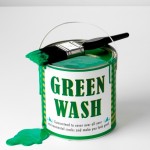
Today, when you go to almost any store, you will find some trace of the “green thing”. You may find energy efficient light bulbs at Home Depot, rechargeable batteries being pushed at stores like Best Buy, or the lack of plastic shopping bags at Costco. These are all signs of a changing environment for the average consumer.
Let’s go back a decade, did you see all of these things? I didn’t, but then again I wasn’t looking very hard back then. The real change is in the hearts of the consumer, but why is being green better? Is it cheaper, not always. Then how is it more beneficial to me? Maybe it is because it is more sustainable? YES!
Okay, now for the next part: what does sustainability mean? It means a lot, literally… from the way the resources for a product were made or obtained, down to the ingredients, manufacturing and distributing process, even things like employees having benefits such as health insurance. Most people do not realize this. So who is responsible for correctly marketing that Green product on the shelf? Sadly there are not enough third parties concerned to monitor the accuracy of manufactures green claims, so plenty of products loosely or falsely advertised as being “green” get by.
After reading Wendy Knowlers Blog Consumer Watch article “Any idea how ‘green’ that product on the shelf is?” about the same subject, I realized that “are we really making informed choices?”
The answer is NO. We are easily persuaded by marketing techniques, leaving the resposibility on the company to correctly and truthfully market their products, which doesn’t always happen. Case-and-point; recently Fair Cape spokesman retorted after being question about whether their products are actually “Free Range”
“We did not call the milk ‘Free Range’, we called it ‘Fair Cape Free Range'” – That is, Fair Cape’s take on free range.
This is the type of attitude that gets consumers in trouble, this company is playing the system. They are capitalizing on a popular terminology that is equated with being sustainable, when in actually there is nothing sustainable about how they treat their cows. This is a prim example of GREEN WASHING.
We try our hardest at Maxi to correctly market our products and stray away from Green Washing techniques practiced by plenty of our competitors. We don’t confuse you with the terms “Recyclable” vs. “Made from Recycled Materials” we are straight shooters, the straightest that I know.
Whether it’s about how your food was brought to table or what was previously in your Rain Barrel, make sure that you aren’t being fooled into buying a product that isn’t truly green. Beware: it’s a buyers market with little responsibility for green washing, companies find ways to creatively brand and sell their products catered to what the buyers are looking for, regardless if they are 100% accurate claims. The weight is on your shoulders, I suggest you equip yourself with a mobile app call GoodGuide (they also have a website, for all of you not currently on the Smartphone bandwagon) to determine before you buy how Good that product really is. You just have to scan the bar-code and wait for the products score to appear. I hope you check it out.
What do you think about Green Washing, has it happened to you? Please comment below to strike up a conversation with us!
Tags: Android, App, business, Consumer, free range, GoodGuide, Green, Green Wash, Green Washing, iPhone, Marketing, Misleading, Popular, Products, Shopping, Smartphone, third-party
Posted in Blog, Latest News | No Comments »
Tuesday, November 8th, 2011
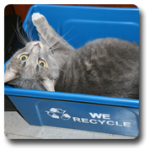
We are very excited about our newest product line, Recycling Containers! This past month we started using them in our office. We consulted with Midstates Recycling, on what we can recycle, they provided us with 10 Gaylord boxes to help us get started. We are currently are recycling:
- Paper
- Plastic
- Styrofoam
- Cans & Bottles
*Batteries are also being collected.
We hope to see this recycling system grow, we encourage our employees to bring in recyclable material an provided each with a Multi-Recyler to kick-off the initiative. We try and reuse office supplies such as folders, binders, paper clips etc… as much as possible as well.
To start a recycling system first you have to know what your goal is. What you are able to recycle in your area, as well as strategically placing (highly visible) bins for collection.
For more information about Maxi’s Recycling System or if you are interested in starting one for your company, please contact Joshua by leaving a comment below or via email.
View the original (November 2011) eNewsletter this article was featured in here.
Posted in Blog, Latest News | No Comments »
Friday, November 4th, 2011
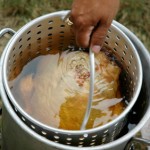
Deep fried turkey is delicious. When done right it is juicy, golden brown, and done much quicker than in the oven. If done wrong, you can sustain serious burns, damage your home and even die. According to data from the USFA, an estimated 2,000 Thanksgiving Day fires in residential buildings occur annually in the United States, resulting in an estimated average of 5 deaths, 25 injuries, and $21 million in property loss each year. The leading cause of all Thanksgiving Day fires in residential buildings is cooking. In addition, these fires occur most frequently in the afternoon hours from noon to 4 p.m. One article states the deep frying alone accounts for an average of 5 deaths, 60 injuries and more than $15 million in property damage can be attributed to deep fryers each year.
You can look at YouTube and see some of the results of people trying to deep fry a turkey and ending up with a fireball instead. Here are a few of my favorites:
- Radio Show sets couch on fire.
There are many many more, just search “deep frying turkey disasters” or something along those lines to get the best results.
Every year at this time people come into our office and want to buy one of our smaller steel drums to build a deep fryer for their turkey. They are shocked when we tell them that none of our drums are appropriate for that use. While we have new food grade drums that make excellent smokers, barbecue grills, wood stoves, we feel that the danger and liability for a home made deep fryer is just too great.
So do yourself, and us, a favor. Soak you turkey in brine, inject it with marinade, cook it on a grill (that’s what I do), put it in a smoker, use different rubs or seasonings. Just do not ruin your Holidays by being one of those 5 deaths or 25 injuries. Enjoy this time with your family and friends. Build a fire in a fireplace, don’t turn your turkey into a fireball.
Tags: Deep Fried Turkey, Drums, Fire, Fire Hazard, Fires, Steel Drums, Thanksgiving, Turkey
Posted in Blog, Latest News | No Comments »
Monday, October 31st, 2011
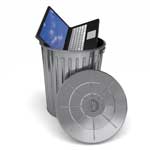
I am old enough to remember a time when appliances and electronics were expensive, big and lasted a long time. Due to their cost, you fixed things that broke and they did not quickly become obsolete. Every neighborhood had a TV Repair Service or a Handy-man who could fix TV’s, radio’s, phonographs, appliances, vacuum cleaners, etc. A recent AARP article (see, I am old) updated the old 50% rule. In essence, if the repair cost less that 50% of the replacement cost of an item, then repair it.
Sadly, this old rule is at odds with our current digital age and Moore’s Law. Moore’s Law is named after Intel co-founder Gordon E. Moore, who described the trend in a 1965 paper. He noted that the number of components in integrated circuits had doubled every two years from the invention of the integrated circuit in 1958 until 1965 and predicted that the trend would continue.
I bought my first “personal” computer, a Commodore Vic-20 in 1980. I still have it sitting in our basement. I bought my second PC in 1985, a Tandy 1000. Since then, the number of computers I have bought are t00 numerous to mention. It seems, like Moore predicted, that I would be replacing a computer every few years. Sometimes it is because something went wrong with it, but often, it is just because I need (or want) a newer, more powerful and faster computer. It is even worse with cell phones. I had drawers filed with close to twenty old cell phones. Often they worked fine, but I received a newer phone with better features by re-signing another 2-year contract with my wireless provider.
As mentioned in the My Life Scoop Blog, the United Nations Environmental Program estimates that each year, 20-50 million tons of e-waste is dumped into landfills around the world, ranging from old phones, TVs, microwaves, computers and more – but most of the time it’s not because these gadgets are defunct; they’re being dumped in favor of new releases. They go on to say that most people fail to properly dispose of their unwanted electronics, carelessly trashing them without regard to the hazardous materials they contain, including PCBs, lead and mercury. Many of these chemicals are known to cause cancer, respiratory illness, and reproductive problems, and damage the earth by seeping into the soil and ground water.
My wife finally had enough of this e-waste build up and in no uncertain terms told me to find a home for all these gadgets. Fortunately, we live in Farmington Hills, MI and our local recycling authority, RRRASOC accepts e-waste at its Southfield location. They also accept e-waste at the various Household Hazardous Waste Collection Events that they hold throughout the year.
RRRASOC points out that e-waste:
“…is the fastest growing portion of the municipal waste stream. As those products reach the end of their useful life, it is important to remember that many of these products are reusable, recyclable, or pose a concern if not handled properly.”
It is important to use an e-waste recycler that you trust. There are some e-waste recyclers out there that say they recycle the e-waste in an environmentally sustainable manner, but in reality do not. A recent Waste & Recycling News article stated that for the first time criminal charges have been filed against electronic waste recyclers accused of duping customers and sending e-waste abroad to developing countries.
According to the article:
“…the indictment says the company developed a scheme to falsely represent that it would dispose of all e-waste in an environmentally friendly or green manner. The company also said it would recycle the items in the U.S., not overseas… Executive Recycling was the subject of a “60 Minutes” report in 2008 which tracked containers from its facility to Hong Kong.”
Executives for the company could spend up to 20 years in prison, if convicted on the most serious charges. An even better way to get rid of functional e-waste is to donate them. Most schools, charities and places of worship run on very tight budgets. What appears to you as an obsolete computer or printer, may be a step up for them or one of their clients. At this years Plymouth Green Street Fair, unwanted e-waste was donated to raise money for Beaumonts’ Chidren’s Hospital. Another exhibitor collected used cell phones to be turned into prepaid phone cards for US Soldiers in Iraq and Afghanistan to call their families.
Despite these efforts, the e-waste at both my home and office continues to grow. If you have a good suggestion for a way to recycle or donate e-waste, please let us know in the comments.
Related Links:
Tags: cell phones, computers, digital, e-waste, electronic recycling, electronic waste, electronics, ewaste recyclers, pc, PCB's, recyclers, Recycling, Reuse, RRRASOC, sustainability
Posted in Blog, Latest News | No Comments »
Saturday, October 22nd, 2011

My great grandfather, Charlie Rubin, was a founding member of the National Barrel and Drum Association. My grandfather, Max Rubin, was a strong supporting member as well, and looked to by many as a patriarch of the organization. He along with my father Richard is only one of two “Father & Son Duo’s” to win the Morris Hershson Award of Merit. I have been active in RIPA for about 2 years now, and it has proven to be interesting and fun. It is the coming together of our Industry from across the country to learn from each other, catch up on family happenings and more. The beautiful thing about this organization, though a decreasing faction, is the pride it takes in the independent family owned businesses that were the original creators of the group, as well as some of the most outspoken and active members. I could detail the history of our families involvement in RIPA for many pages, but I am not writing this article because of that. I actually want to shed some light on another Michigan Family Business, and their legacy.
Peter DeWitt of DeWitt Barrels won the Morris Hershson Award of Merit this year. I want to formally congratulate him on this award, as well as share my thoughts on both of our family’s impact on the Michigan economy. I do not think that it is a coincidence that the previous winner of the award was also a Michigan family owned business (My father Richard won the Morris Hershson in 2009). I also do not think that it is a coincidence, but rather an imperative statement of or our economy in Michigan, that despite a decrease in the amount of jobs and cutbacks in all sectors of government across the board, that these two family owned drum companies still thrived. Maxi provides over twenty families with jobs and benefits. We also try and provide a comfortable and fun work environment. (We even have office cats to lighten up the mood!)
I don’t want to get too far off topic here. Peter DeWitt, like my father, both have driven their respective companies forward at full speed during this most recent recession. Business leaders could learn a thing or two from these guys! DeWitt focuses on the reconditioning process and now Recycling, while Maxi has a broader product offering but doesn’t process drums in house. We do a lot of business back and forth, but more importantly we are both invested in competing with the bigger conglomerates for Michigan customers. It is a testament to both organizations that we continue to thrive in this highly competitive environment.
The message of this blog is too support your neighbor, your friends, and your fellow community members, whether you are competitors or complete strangers. The bottom line is the more you buy local and support your states economy, the more likely the benefits will come back to you. I want to again say that Peter has been a strong voice and active member of RIPA, standing up for reconditioners. Both past Chairman of RIPA, my father and Peter represent something that is dying in our industry:
“REAL BARREL MEN!”
Related Links:
Richards Acceptance speech 2009.
Reusable Industrial Packaging Association (RIPA) Website.
Tags: Barrels, business, Charlie Rubin, Economy, family-owned, Max Rubin, Michigan, Morris Hershson, Morris Hershson Award of Merit, NABADA, Peter DeWitt, re-conditioners, Reusable Industrial Packaging Association, Rick Rubin, RIPA, Totes
Posted in Blog, Latest News | No Comments »
Thursday, October 6th, 2011
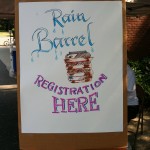
A few years ago, when we set out to get involved in making Rain Barrels and selling other Home and Garden products at Metro-Detroit Green Fairs, we never thought it would turn out so incredibly well. The community involvement with green fairs, charities, school and churches has helped shape our business, continuing over a hundred years of Rubin family involvement in the drum and barrel industry. Now, at Maxi, as the summer comes to a close, so does a chapter of our lives. The Green season is over, there no more events until next Spring/Summer. We all set our sights on the numerous things we have neglected due to the hustle and bustle of the season. We won’t be hibernating this winter, but a part of us will. The Green part.
I thoroughly enjoyed all of the events we were involved in (a list is provided at the end of this post). However, certain moments, or days, stand out when looking back from the corner of the autumn and winter seasons. I want to share my favorite “highlights” from this summer with all of you.
Two tents down! Currently, both of our tents need repair. One, we have no idea what happened to, and the other a storm almost swept away! At the St. Clair Shores Green Fair in the Park it was a beautiful day until warnings of a oncoming storm started to spread across the fair (since the Dream Cruise was happening on Woodward Ave. simultaneously, we just checked their twitter feed) Even though the vendors and patrons were advised to leave a little early in hopes of missing the brunt of the storm, we were among the last out of there, and our tent nearly didn’t make it out at all. I went to grab the truck for our final load of Rain Barrels, and when I arrived to our location I find my father (Richard) holding onto a tent that was in shambles. He looked like he was holding onto it for dear life, in high winds and heavy rain. This was a very intense end to a great event.
HOT, HOT, HOT! All of you remember that heat wave in June? Well we can’t forget it. We had three events planned almost simultaneously for that weekend of heat. Friday I spent in Armada while the rest of the Maxi staff was at the Ferndale Live Green Fair. I guess this is one time I lucked out, since at the Lavender Festival in Armada we had a location in the shade and the fair was on grass, not pavement. The staff at the Live Green Fair said it was sweltering hot as the intense sun reflected up from the ground. Also, the way the booths were set up didn’t allow a lot of airflow. On Sunday, I made my way to Ferndale, my father and I did the best we could, but I was definitely suffering during tear down, and was afraid I was going to pass out. My Dad had to stick me in the car with the AC on to get me to stop acting loopy. I am pretty sure I was a second away from heat stroke.
We enjoyed all of the events this year, these two weekends were exceptionally interesting, check out the list below for all of our events this year, and watch out for even more next year! Hope to see you next summer at some of our Green Events!
I tried to remember them all and hopefully, got them all of them here. Click on each to learn more. This list doesn’t include all of the Rain Barrel workshops we have done, just a few of them.
If you know of an event in Metro-Detroit (really anywhere in Michigan) that you would like us to bring our sustainable living setup including Rain Barrels, Composting, and Container Gardening, please let us know. Drop me an email at joshua@maxicontianer.com with the details.
Enjoy this slideshow of photos from our “Green Fairs” Collection of photoset’s on Flickr!
[slickr-flickr tag=”GreenFairs” type=”slideshow” captions=”on” delay=”3″]
Tags: Armada, Birmingham, Compost, compost tumbler, Composter, Composting, container gardening, earth day, East Lansing, Fair, Ferndale, Ferndale Perennial Sale, Garden, gardening, Grassroots, Great Lakes, Great Lakes Folk Festival, Green, Green Breeze, Green Fairs, Green LIving, home and garden, Live Green, local motion, Metro-Detroit, Michigan, Perennial, Plymouth, rain barrels, Rick Rubin, Rochester, Sierra Club, Sierra Club Great Lakes, St. Clair Shores, sustainability, Water
Posted in Blog, Latest News | No Comments »
Monday, October 3rd, 2011

New technology is one of the biggest catalysts for our economy, always has been and always will be. Right now, scientists in China have been introducing cleaner and greener tech, which creates fewer by-products while saving money. These new technologies are coming at the right time, when costs for fuel are higher than ever and companies are looking for ways to reduce costs. Taking all of this into consideration, these scientists have been working on a new composite material made from wood and plastic that will be better for the environment, create no harmful by-products, be stronger than traditional recycled plastic and (supposedly) cheaper! What is there to lose? Many industries, such as the automobile and textile, have already started adopting this tech in China. Soon it will be ready for the world. To break it down further, I have created five little sections below that explain the Wood Plastic Composite (WPC) and how it will change these industries and why it is better and more desirable than just recycled plastic on it’s own.
Humans are wasteful; it’s in our nature. Luckily, we also are smart enough to develop new technologies like WPC. Now the smaller branches of trees, saw dust and other waste wood pieces, which otherwise end up in a landfill, can easily be turned into a composite material made by binding the wood with plastic polymers.
What does this mean for you? Maybe not much right now, unless you are in the market for a new deck (which the material is already being used for) but what it will lead to, is new a new material made from the waste. Reusing wood waste is inherently eco-friendly. However, the most ecologically minded aspect of this new tech is the end product itself. The plant fiber-based composite will reduce the cost of the production of wood while simultaneously reducing the industries negative impact on the environment.
Who came up with this great idea? Scientists from the Institute of Wood Science and Technology (IWST) developed the technology in China. Many people are already importing this technology from China. When asked about the possibilities of this new material, Dr. Ajay Karmarkar, a scientist working on the project with IWST said,
“The experiment was being conducted for the past 10 years and finally we came to a conclusion that the by-products can be used by automobile, packaging, and textile industries. Plastic hangers and buckets, wooden door frames and windows can be replaced by this ecofriendly composite material.”
What are the advantages? Once plastic is recycled, its usage becomes less because it loses stiffness. WPC will increase stiffness by 70% and at the same time, be 50% less expensive than it’s traditional wood counterpart. Plus, during the manufacturing process, the only by-products that are created are 100% environmentally friendly.
How do they make WPC? The process takes fibrous material from wood, bamboo and jute, mixes it with the plastic polymers and run it through the twin-screw extruder. This machine melts, mixes and pumps the product. This by-product is then put into a pelletizer, which chops it up into tiny granules. To get the desired size and shape the granules are put into the injection-moulding machine next. Finally the WPC is put through tensile stiffness and compression strength testing.
Since being debuted WPC has won over many industries, ones which welcome the idea of new technology. The benefits for the environment and production are numerous and the overall cost is lower. Soon we hope to see WPC in more products all over the world. Maybe, it will even show up soon in our Industrial Packaging.
Original Source: Luna Dewan, The New Indian Express
[slickr-flickr id=”47075868@N00″ tag=”WPC” type=”slideshow” captions=”on” delay=”3″]
Tags: China, Composite, deck, eco-friendly, injection-moulding, Institute of Wood Science and Technology, IWST, Plastic, Plastic Polymers, Polymers, Reuse, Sawdust, Tech, Technology, waste, Wood, Wood Plastic Composite, WPC
Posted in Blog, Latest News | No Comments »
Friday, September 23rd, 2011

In March of this year the American Beverage Organization brought suit against the State of Michigan claiming that the 2008 amendments requiring Michigan specific labeling on beverage containers sold in Michigan violate federal interstate commerce clause. Michigan has the highest deposit on beverages in the country at 10¢. A famous (or infamous) Seinfeld episode had Kramer and Newman attempting to profit by returning non-Michigan beverage containers to Michigan and make 5¢ a can/bottle. Apparently they were not alone and in 1998 the Michigan Legislature passed an amendment only criminalizing the fraudulent redemption of containers. In 2008 the legislature criminalized the knowing acceptance by retailers of fraudulently redeemed containers and required that Michigan specific labeling be placed on deposit cans and bottles sold in Michigan. The provision, M.C.L. § 445.572a., states:
“A symbol, mark, or other distinguishing characteristic that is placed on a designated metal container, designated glass container, or designated plastic container by a manufacturer to allow a reverse vending machine to determine if that container is a returnable container must be unique to this state, or used only in this state and 1 or more other states that have laws substantially similar to this act.”
The requirement of Michigan specific marks only apply to deposit beverages that sell over 500,000 cases in Michigan per year. In May 2011 The US District Court ruled in favor of the state and found that the Bottle Deposit law did not violate the interstate commerce clause of the constitution. Furthermore, the court stated, that due to the high threshold requirements, not every beverage maker is required to mark their bottles specifically for Michigan. The court noted, “For example, for 12-ounce metal containers, the non-alcoholic beverages subject to the provision are: Coca-Cola,Diet Coke, Caffeine Free Diet Coke, Sprite, Coke Zero, Cherry Coke, Pepsi, Diet Pepsi, Mountain Dew, Diet Mountain Dew, Diet Caffeine Free Pepsi, A & W, Dr. Pepper, and Vernors. While the District Court upheld the state specific markings, the Sixth Circuit Court of Appeals has agreed to hear an appeal by the American Beverage Association of the Circuit Court’s ruling.
The proof the Michigan Bottle Deposit law works is that Michigan has the highest redemption rate of any of the states with Bottle Deposit laws. I am pleased that the Circuit Court upheld Michigan’s Beverage Deposit Bill, however I believe that it and similar laws in other states no longer accurately reflect current consumer tastes in bottled beverages. The Michigan law does not cover, bottled water, fruit juice and sport drinks. While Michigan residents can take pride in our high rate of redemption for those bottles with a 10¢ deposit, a Michigan Recycling Partnership study found that only 37% of Michigan residents have access to curbside recycling, the lowest in the Great Lakes region. I firmly believe that curbside recycling is the best method, moving forward, to increase recycling rates in Michigan. However, until cash strapped communities can convince their citizens to pay for curbside recycling, an expansion of the bottle to include, among other beverages, bottled water, is necessary.
As pointed out in the Kalamazoo Gazette, of the 70 million water bottles consumed each day, only 10 million are recycled. Most end up in landfills or littering our streets and walkways. An expansion of Michigan’s Bottle Bill is needed to motivate us to redeem the millions of bottles of water, juice and sports drinks consumed by our citizens. According to the Detroit Free Press, non-carbonated beverage containers now litter our roads and parks, making up to 50% of the trash picked up by park maintenance workers at public expense. Because non-carbonated beverage containers are excluded from the bottle bill, consumers have no incentive to recycle them, and only 20% of 1.4 billion non-carbonated beverage containers are recycled each year in Michigan.
The Free Press went on to say, public parks are a key component of the quality of life in every community. Keeping them beautiful and litter-free benefits every citizen. By getting all of the bubbles out of the bottle bill, we finally can get bottle litter out of our parks and reduce maintenance costs at the same time. All of us here at Maxi Container agree wholeheartedly. The Bottle Deposit Bill was originally passed in 1976. It is now time to update it, we need to expand the bottle deposit bill to include all of the various juice, water and other non-carbonated drinks that we now consume more frequently. You would be hard pressed to find a carbonated beverage in my home, but we have many types of juice, energy drinks and sports drinks. What about you, how has your beverage consumption habits changed? Do you commonly drink soda or fruit juice/sports drinks? please leave us a comment below.
Tags: 10¢, American Beverage Organization, bottle, bottle deposit, cans, containers, glass, juice, metal, Michigan, non-carbonated, Plastic, soda
Posted in Blog, Latest News | No Comments »
Wednesday, September 7th, 2011

On August 31st, Compuware debuted its newest creation (and it’s not software) Lafayette Greens, an urban garden located at the old Lafayette building site, which was demolished in 2009. The community garden will provide all organic produce for Gleaners Community Food Bank (and if there is an over abundance of produce, it will go to the volunteers too!). The garden will be maintained almost entirely by a volunteer workforce. I was fortunate enough to join them for the grand opening celebration.
This initiative is run by Compuware employees Gwen Meyer (onsite manager) and Meg Heeres (project manager). We had the pleasure of meeting them during the development of the garden, consulting on the design types possible with our containers. They eventually had to resort to custom made beds for the majority of the garden, but still utilized our drums in the “Children’s Garden”. In this section our used juice drums were placed in a circular design which is lower to the ground so kids can interact with the plants better. It has a very “zen” feel to it.
The event was spectacular, samples of gourmet cuisine made from fruits and veggies grown in the garden were being passed out. Free drinks (non-alcoholic) and lively music was playing. The news obviously was informed about this event, I think I saw one person from every major local station there! This event was well planned. I enjoyed my afternoon there, though I mostly just hung out in the Children’s Garden where our containers where displayed.
They also are utilizing one of our compost tumblers, though I don’t think a single tumbler will be able to supply the entire gardens needs. The footprint of the garden is the entire corner, it’s pretty big. I urge any and everyone who is in the downtown Detroit area to go in and check it out!
We are so happy to be involved in the beautifying of Detroit with Compuware. At Maxi, we are dedicated to getting involved in our community and the amount of gardens going up in Detroit this year was amazing. We urge others to develop community gardens and work together to turn vacant lots into functional and beautiful gardens. This is the green movement and companies like Compuware and Maxi, and people like Gwen and Meg are what our city needs. Take a moment to check and see if there are any projects planned for your community.
Enjoy this slideshow of pictures from Compuware’s Lafayette Greens Community Garden. You can view these photos on our Flickr as well.
[slickr-flickr search=”sets” set=”72157627569688870″ type=”slideshow” captions=”on” delay=”3″]
Lafayette Greens is on Facebook!
Tags: 55 gallon, 55-gal, 55-gallon steel drum, 55-gallon steel drum planter, children, children's garden, Community, Community Garden, compost tumbler, Compuware, Container, Detroit, Food Bank, Garden, Gleaners Community Food Bank, Green, Greens, Lafayette, Lafayette Greens, Organic, Organic Produce, planter, Produce, Urban, Urban Garden, used containers
Posted in Blog, Latest News | 2 Comments »
Friday, September 2nd, 2011
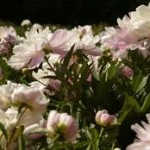
There are many wonderful things about the city of Ann Arbor and the University of Michigan. I have many fond memories of my college days there. One of my favorite things both during and after my school days, is walking along the trails and enjoying the beauty of the Nichols Arboretum. For those of you that are not familiar with it, the Arboretum (or “Arb” as it is called by the students) the University of Michigan created a Botanical Garden and Arboretum in 1907 on the land between Geddes Road and the Huron River, just a few blocks from Central Campus on the site now known as Nichols Arboretum. At the time, the property consisted of approximately 80 acres. Today, more than 100 years later, the University of Michigan Matthaei Botanical Gardens and Nichols Arboretum manages over 700 acres of gardens, research areas, and natural preserves around the Ann Arbor area with a complex of conservatory, greenhouses, laboratory, teaching and meeting spaces at Matthaei Botanical Gardens and the James D. Reader, Jr. Center for Urban Environmental Education at Nichols Arboretum.
For me, the Arb was a place to get away from the stress of my studies and take a long walk on a sunny spring or fall day. In the winter, we went sledding, tubing or “traying” on it’s many hills. One such winter afternoon lead to one of my many encounters with the U of M Health Services as they x-rayed a sprained thumb brought on by an extreme traying session. (For those of you who are not familiar with the sport, traying is the sport of sliding down a steep snow covered hill on a tray from the U of M Food Services (i.e. cafeteria).
In the summers, we held numerous picnics, Frisbee games, touch football games or just spent a lazy afternoon laying on a blanket and reading a book. The Arboretum never failed to enchant or excite as it changed with each season. Now, my wife and I, after visiting our daughter, take long languid walks in the Arboretum. We talk about the past, plan for the future and just relax in a beautifully maintained natural space. One of my wife’s favorite parts of the Arboretum is the Peony garden. We make sure to visit the Arboretum in late spring and early summer to see the over 230 varieties of peonies in bloom.
You can imagine my pleasure at reading the other day that U.S Senator Carl Levin (D–Mich.) announced in a July 26 press statement that the Botanical Gardens and Nichols Arboretum are among five Michigan museums that will receive federal grants through the Museums for America program to preserve local establishments.
“Michigan’s Museums are home to many important state and national treasures, and these grants will help share those resources with more visitors,” Levin said in the release. “I am proud these museums were selected out of scores of applicants nationwide, reflecting the great work being performed by these institutions.”
According to the press release, the University will receive $79,658 from the Museums for America grant as well as matching funds provided by the grantee to be used on the “Peony Initiative,” which will provide information on the Internet about the garden’s various peonies. The money provided by the Museums for America grants is only one piece of the peony project, which includes restoration and expansion, among other improvements, that are already several years underway. The Peony Garden was donated to Nichols Arboretum in 1922 by Dr. W. E. Upjohn, founder of the Upjohn Pharmaceutical Company in Kalamazoo, Michigan. The Peony Garden is home to historic varieties of peonies that were introduced into gardens throughout the nineteenth and first half of the twentieth century. Here is a slideshow of photos from Flickr that are tagged “nicholsarboretum” courtesy of cseeman
[slickr-flickr tag=”nicholsarboretum” id=”7702423@N04″ type=”slideshow” delay=”3″ captions=”on”]
I have written about two of my favorite natural places, the Coral Reefs off the coast of Eilat and now, the Nichols Arboretum, I would love to hear about some of your favorite natural places too?
Tags: Ann Arbor, Arboretum, Botanical Garden, Carl Levin, Garden, Gardens, Levin, Matthaei Botanical Gardens, Michigan, Museums for America, natural, natural places, Nature, Nichols Arboretum, Peonies, Peony, Peony Garden, U of M, University of Michigan
Posted in Blog, Latest News | No Comments »
Thursday, August 18th, 2011
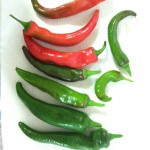
Living in an apartment and condo does NOT mean you can’t garden. And people, I’m not talking about one or two hanging plants. I am talking about really gardening… fruits, veggies, flowers, and herbs. Right now I have tomatoes, potatoes, onions, corn, jalapeno and cayenne peppers, plus a herb garden and a few flowers for accent, all on my patio. You must be wondering just how I fit all that on my small 5′ x 10′ patio? Well let’s just say, very creatively. By utilizing hanging hooks on stands that fit four pails each, and two half pallets (I sawed one in half basically), I can make a varying array of configurations that are both beautiful and at the same time add a sense of privacy to our patio.
Another benefit of my container garden is the family activity it creates. My fifteen month old daughter grabs my hand and begs to be a part of the gardening experience. I supply her with her own little watering can and a plastic spade shovel to dig in the dirt with me. This is a family garden. It has become a central part of our family life. Whether it is the wife and I relaxing after the baby has gone to sleep, or working together to harvest some basil to make pesto for dinner, it is enjoyable and bring us even closer together. If you live in a apartment or condo and think that gardening is just too much to handle, reconsider. Give it try. We have previously used food grade 5-gallon pails perfect for starting your very own garden. Please email me at joshua@maxicontainer.com for a free consultation. We can design your pails to fit the types of plants you want to grow. We have three styles right now for our 5-gallon pails, they are:
- Traditional planter
- Hanging tomato planter
- Pepper / strawberry planter (Can hold up to 6 plants)
*can easily be made into a self-watering planter
We also have experimented with our 30-gallon plastic barrels, turning one into a strawberry planter. We cut a plastic juice drum in half, attached wheels and handles to make a movable planter perfect for all types of plants. Like I was saying before, the possibilities with container gardening are endless. You only will be limited by your own creativity. So, what are your waiting for? Try it now. Give us a call today and get the low-down on what you’ll need to get started. And please, if you don’t get your container from us just make sure the containers are food-grade. Ask what the previous contents where. If it was something questionable, DO NOT USE IT. If it had food in it before, then its fine. It’s better to ask then to just say “ohhh it’s fine because it was free.” You will be growing and eating food from that container. Plastic absorbs some of its previous contents; there is no way around that, it is in the material’s nature. So any reconditioned or used plastic barrel, is not always safe for growing plants. Hope this information helps get you started container gardening. Here is some photos from our Flickr photoset “Container Gardening”.
[slickr-flickr search=”sets” set=”72157627032002916″ items=”20″ type=”slideshow” delay=”3″ captions=”on”]
Tags: 5-gallon pails, apartment, condo, Container, container gardening, food-grade, gardening, Green, pails, Previously used, sustainability
Posted in Blog, Latest News | No Comments »
Saturday, August 13th, 2011
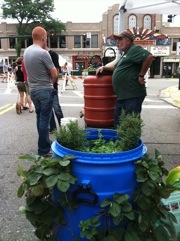
So when you buy previously used… You don’t get to be picky. Sometimes there is a dent or a scratch. Maybe each container is not the same size. These difference are what make our products unique, why they still sell better than their corporate counterparts. We don’t just sell you a rain barrel, we sell you an idea… We help you reduce your carbon footprint and “point-source-pollution”. When you buy a Home & Garden product from Maxi, whether it be a drum stove made from a steel drum or a pickle barrel turned into a rain barrel or compost tumbler, you are reusing a container for a sustainable purpose. Your rain barrel or compost tumbler’s function is exactly that, to save rainwater and make nutrient rich compost but there is more too it the that, we want you to know that we do this so you can be proud of that barrel. You can tell your friends, family, neighbors, the clerk at the local grocery store, just tell whoever about it’s environmental benefits and hopefully they will tell somebody. We believe in what we do and thats a start, hopefully soon more people will realize it’s not about how the barrel looks (though we try and get the best style “terra cotta” color barrels we can find) but what it does. I guess it’s the age old argument of what matters more, fashion or function? What do you think about aesthetic versus the purpose or function of a rain barrel? Let me know here or please go ahead and tweet me @MaxiContainer.
Tags: 5-gallon, food-grade, pails, Previously used
Posted in Blog, Latest News | No Comments »
Tuesday, August 2nd, 2011

This summer has been a busy one for us here at Maxi Container, Inc. Our Rain Barrels, which started as a tiny side-project for us, have turned into an entire Home & Garden product line. This line now includes Rain Barrels, Compost Tumblers, Compost Tea Kits and our newest product…(drum roll please) container gardening! We are currently testing out various container gardening designs for our pails and barrels. Expect to see them soon on our website. You may have already seen some of our container gardening items at one of the many Green Events we have been at this year. If you haven’t already please check out our Flickr “Container Gardening” photo set here.
At Maxi, our passion does not end with our workday. We have a love for being involved in our community. To that end, we work with schools, churches and other non-profits such as the Sierra Club Great Lakes Program to help spread the word about water conservation, composting and reuse.
From rain barrels to rain gardens, from composting basics to compost tea, we are involved in every step of our products design and manufacture. (Technically speaking, its re-manufacture, since our Home & Garden products are made from used food grade containers). Nothing goes unnoticed and if anyone has a question or complaint (no matter how small), we make sure to take care of it. That’s what you get when you choose MAXI.
Now, with that all being said, as one of my favorite frogs once said, “It ain’t easy being GREEN.” Our Home & Garden line has turned into a full-time job. Our Twitter is full of eco-friendly tweeters and gardeners. Sometimes we participate in green fairs and community events two to three weekends in a row. When you add in the time it takes to get ready for these events, you can see how hard we are working to promote our core concepts of sustainability, reuse and conservation. Why do we do it? Just take a look at this past month of July…
We arranged to be involved in three different events one weekend and had another event the next weekend. Within nine days, we had four events. If you asked me last year at this time if we would be at that many events, I would of simply answered “not possible”. Now my attitude is different and the sky is the limit.
The first event was the Ferndale Live Green Fair. While in its second year, it is still in its infancy. Last year the Live Green Fair was part of the Funky Ferndale Art Fair and it had only eight or so vendors. However, it was a great success. This year it became a standalone with over 80 GREEN vendors. The event was beautiful, with fun for all ages. The only downside was the heat. This past July turned out to be one of the hottest on record for metro Detroit, and the Live Green Fair happened to be smack dab in the middle of one of our biggest heat waves. I applaud any of the people who made it out to the Ferndale Live Green Fair. We thank you for braving the high temperatures! This green fair is by far the truest green event (the creators are extremely green guys!) and it has a lot of potential. Let’s just hope that next year there is better weather!
Our second event was the Lavender Festival in Armada, MI, hosted at Blake’s Cider Mill. Though not a “Green” fair per say, the event had many green vendors, organics for your garden, artwork made from reused materials and of course, lots and lots of lavender! There was also an education tent that had a workshop every hour. I taught a workshop on Friday that was very successful and had a great time interacting with interested gardeners. We had a great time here and hope to come back again! Thank you to Jennifer Vasich, who created the event and who asked us to be a part of it for the first time.
Our third event of the weekend was part of Farmington’s Founders Festival. We had a very successful workshop with the Salem United Church of Christ in Downtown Farmington. Read the full article here.
The next weekend, we took part in Birmingham’s Green Breeze on the streets of Old Woodward. Richard Rubin (my father) and I set out to see what all of the local Birmingham residents were up to. The turnout for this event hasn’t been as great as we would like, but the people we meet at it seem to be committed to the same values as we are at Maxi. I had some great conversations, met some really exciting and cool new people, and sold a few rain barrels. We also saw many familiar faces. Overall, it was a good weekend and a relaxing final show for our busy two weeks.
Why have I gone into such great detail to illustrate what we did this summer? Some of you may ask why do these Industrial Packaging guys give up their hard-earned weekends? We do it because here at Maxi we believe in our community and in empowering people through education about reuse and sustainability. Stop and think about it. If more businesses operated like Maxi, wouldn’t the world be a better place? The bottom-line is not always about making a dollar. Sometimes it’s just simply about making an impact.
Hope to see you at one of our upcoming green events… check our Facebook or Follow us on Twitter for up to date news on where we will be!
Tags: Armada, Barrels, Birmingham, Compost, Compost Tea, container gardening, Fairs, Farmington, Ferndale, Green, Green Breeze, Lavender Festival, Live Green Fair, rain barrels, Salem Church, Workshops
Posted in Blog, Latest News | No Comments »
Thursday, July 21st, 2011
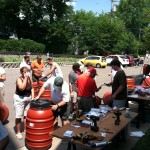
Here at Maxi Container we have many sayings, some are left over from our founder, Max Rubin. Not all are polite or politically correct, but are distillations of business wisdom passed from generation to generation of the Rubin family. The saying that we use the most is our slogan and core value MAXI means the MOST in SERVICE and QUALITY. We use this as a shorthand for our commitment to customer service before and after each sale. Another one of our core values is being committed to reuse and recycling. Many of the containers we sell are reconditioned. They have been previously used for the transport of various industrial products, collected, cleaned in an environmentally sustainable manner, and then re-certified for reuse. For the past few years we have been up-cycling (re-purposing) food-grade containers as rain barrels and compost tumblers. We have attended numerous green fairs, worked closely with schools and community-based organizations such as the Sierra Club, to promote the use of rain barrels, composting, reuse and recycling.
This leads us to another one of our sayings and core values. Today it simply is not enough to “talk-the-talk” about green products, or your commitment to reuse and recycling. You have to literally “walk-the-walk” to prove to your commitment to the public. Here at Maxi, we pride ourselves on actually following through and “walkin’ the walk”. Our products are often reused or reconditioned, we recycle our office paper and run our trucks on bio-diesel. This past weekend we took our commitment to being green one step farther, farther then we ever have in the past. Maxi was involved in three community events this past weekend, simultaneously! Most of this came about due to the hard work of our Creative Director, Joshua Rubin. This past weekend we were exhibitors at both the Lavender Festival in Armada, MI and the Live Green Fair in Ferndale, MI. We also worked with the Salem United Church of Christ in Farmington, MI to hold a rain barrel workshop were people could learn how to build their own rain barrel. Joshua was the principal speaker and trainer at both Armada and Farmington. He then worked with me in Ferndale on Sunday, in 90+ degree heat.
The result was a wonderful weekend where over 120 rain barrels found new homes. I am very proud of my son Joshua Rubin for his commitment to our core beliefs of reducing our impact on the environment by “Walkin the Walk” and being GREEN.
Tags: Fair, Green, Green Fairs, Joshua Rubin, Rain Barrel, rain barrels, Sierra Club, Workshop
Posted in Blog, Latest News | No Comments »
Wednesday, July 20th, 2011
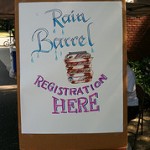
On Saturday, July 16 around 10AM, there was activity starting to take place in the parking lot outside of Salem United Church of Christ in Farmington, MI. The church is located in beautiful, historic downtown Farmington and has been around for over 100 years. Susan Nickels, on behalf of Salem, contacted Maxi Container, and we worked together to prepare a Rain Barrel Workshop to coincide with Farmington’s Founders Festival. Susan organized the activity with the help of her daughter Danielle. We originally started out with a tentative order for 50 barrels. The response was so great that on the day of the workshop, we were expecting over 80 people.
Once people started to gather in the parking lot, it was time to start assembling the rain barrels, to talk with them about water conservation, and how to use their new rain barrels. I came prepared with an assistant, Charlie Ryan, who is a Farmington Hills native. Charlie helped lead the workshop with me. In no time at all, we had a full-blown assembly line in progress. As we were working, more and more people showed up. Many people saw the activity in the church’s parking lot and asked if there were any rain barrels left.
Though we brought ten extra rain barrels, it was not enough. The response was so overwhelming, even the two barrels Maxi donated to the church were sold. Susan and Danielle were ecstatic at the outpouring of attendees for this first time event. Maxi would like to formally thank everyone at the Salem United Church. We would especially like to say thank you to Susan and Danielle Nickels, for making this event happen. From fruition to finish, it went wonderfully and we hope to work with them again.
Don’t worry, we replaced the two donated rain barrels as a thank you for the church hosting the event. We hope to work together in the future on more GREEN events with them.
Enjoy these photos from the event!
If you are interested in having Maxi work with your non-profit or organization to help educate people about Rain Barrels and water conservation, please contact Richard via email: rick@maxicontainer.com
Tags: Farmington, Founders Festival, Rain Barrel, rain barrels, Salem United Church, Water Conservation, Workshop
Posted in Blog, Latest News | No Comments »
Tuesday, June 28th, 2011
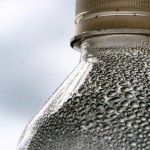
Previously, I posted about many of the problems with our obsession with Bottled Water. These include the millions of plastic bottles that do not get recycled and will last for many years in landfills, the environmental cost of transportation, and the negative effect on our aquifers for the millions of gallons of water pumped from our ground waters, streams and lakes. Apparently, I am not alone in seeing a negative side to this phenomenon. Many people and organizations have tried or succeeded in banning the sales of bottled water.
Washington University in St. Louis, MO has banned the sale of bottled water on campus. Other campuses banning the sale of bottled water include Seattle University and the University of Wisconsin – Stephen Point, Belmont University, Oberlin College, University of Ottawa and University of Portland. Some campuses have not banned the sale of bottled water, but no longer serve it in the dinning halls. These include Gonzaga University, New York University, Stanford University, Stony Brook University and the University of Maryland.
Universities are not the only groups trying to stem the rising tide of bottled water sales and the problem associated therewith. The Dave Mathews Band has partnered with Brita FilterForGood to reduce the amount of bottled water sold at their concerts. Brita’s FilterForGood will provide fans and performers access to free Brita® filtered water. Festival-goers can ditch their bottled water and instead fill up using reusable bottles so that everyone has an opportunity to help reduce the festival’s environmental footprint.
Faced with increasing vocal green opposition to their product, the bottled water industry has decided to fight back. The International Bottled Water Association (IBWA) on Wednesday took on what it described as a “a myth repeated by some anti-bottled water activists that bottled water which comes from municipal water sources is just tap water in a bottle.” They posted a video on YouTube that purports to show how they filter and purify their water prior to being bottled.
Once again, the bottled water industry has missed the point. While one of my problems is that most of the US has access to good drinking water, making their product an unnecessary expense, the bigger issue is the bottles themselves and the energy it takes to get the product to the consumer. Add to that the fact that only about 27% of water bottles actually get recycled. The rest end up in landfills. Even when they are recycled, they have to be transported to the recycling facility, ground up and then transported to be melted into pellets for reuse. That is not a small carbon footprint.
In addition, there are some who believe that the chemicals in PET bottles are harmful to humans. There is evidence that PET bottles may leach harmful endocrine disrupting phthalates.
The IBWA should be ashamed of themselves. They are producing a slickly made video promoting their billion dollar business focusing only on the supposed purity of their product and not the numerous harmful environmental effects of their product. There are numerous reasons why bottled water is bad for the environment. Here are a few:
- We pay three to four times the cost of gasoline for a product that comes free out of the tap.
- We move almost 40,000 18-wheelers worth of water around the country every week–a tremendous waste of energy resources.
- It takes three times the water in a bottle to produce the bottle and fill it.
Clearly, bottled water is not the answer to our need for good clean hydration. Use a refillable water bottle and fill it from your tap. You will be saving money, saving resources, protecting your health and reducing your carbon footprint.
Below is an infographic detailing the top importer and exporters of bottled water in the world.
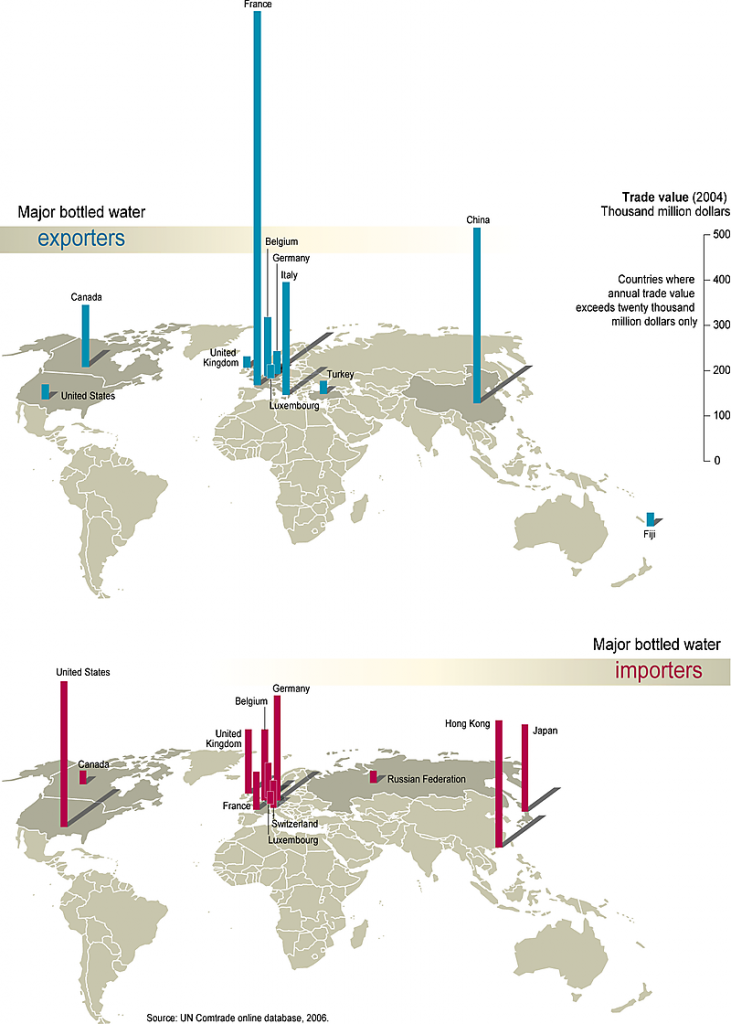
Some art students started a neat “boxed” water company in response to the major issues of the bottled water industry. Please take a minute to check out Boxed Water, started in Grand Rapids, MI. They have good sustainable ideas behind their company. If isn’t a solution at least it’s a start.

Tags: Bottled Water, Boxed Water, Enviroment, International Bottled Water Association, Water
Posted in Blog, Latest News | No Comments »
Monday, June 27th, 2011
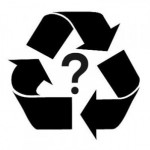
The Sustainable Packaging Coalition (SPC) plans to update the labels used to differentiate recyclable material in consumer packaging. Recently, I have noticed more and more “green-washing” done by companies who advertise that their product is “recyclable”. Though this statement may be true, often this message confuses the consumer, whom at a glance may think it is made from recycled material. Also, even if a company claims that their product is recyclable, that does not always mean that recycling for that specific material is available in your area. To clear up all the confusion, so we all can see this issue clearly, the SPC has decided to update the labeling system for various recyclable materials into four categories.
These categories include:
- Widely recycled – for materials like glass, cardboard, and PET plastic bottles.
- Limited recycling – for materials that are only recycled in 20% to 60% of the U.S., such as #5 yogurt containers or medicine bottles.
- Not recycled – for materials that are rarely recycled, such as Styrofoam*
- Store drop-off – for the bags and plastic film that are generally collected by retailers for recycling.
*For more information about Styrofoam recycling, please read our article about Dart Container and their Styrofoam recycling initiative by clicking here.
|
What does all this mean for you, the consumer? It means simply that the materials you receive all of your favorite products in, and the products themselves will be easier to identify if it is actually recyclable and how to recycle it. Of course, in different areas there are different recycling options available, but now consumers will know more clearly if their product or packaging is recyclable and what steps to take to get it to the right facility to take care of it. It may be as easy as curbside for some of you, or it could be a trip back to the place of purchase. Either way it will be easier to identify recyclable materials.
A limited number of SPC members will be participating in a test run of the project this fall that will run through 2011. SPC hopes that this new labeling system will eventually become universal.
Susan Freinkel, a blogger for Fast Company, wrote about an initiative that is underway to update the numbering systems on plastic containers. Hopefully we will see this system become implemented in the next 2-3 years. This new numbering system should take into account the greater variety of plastics now available in the market. Right now the market is flooded with a broad range of bio-plastics. Only some of these bio-plastics actually are biodegradable. As of now these bio-plastics are mixed into the #7 category along with other non-recyclables.
The recycling world is constantly changing as new materials are introduced into the market. The ability for recyclers to manage the materials they receive is essential to them being successful. The state of the recycling world right now (in particular plastics) is a mess. Bio-plastics along with other materials mislabeled as recyclable, when in actuality they are not recyclable or recycling for such materials is not easily accessible. Overall, the changes the SPC has proposed to help determine how readily available recycling is for specific materials and updating the plastics numbering system for recycling to include bio-plastics, could greatly benefit the recycling world.
Original article: Coalition to Introduce Reality-Based Recycling Labels
From: SustainableBusiness.com
Tags: Labels, Packaging, Plastic, Recycable, Recycling, Recylable Material, styrofoam, sustainability, Sustainable Packaging Coalition
Posted in Blog, Latest News | No Comments »
Monday, June 13th, 2011

While vacationing with my wife Gail and daughter Michelle in Israel, I had the unique opportunity to snorkel among one of the most spectacular coral reefs I have ever seen. In the Gulf of Eilat, or Gulf of Aqaba (near the Israeli resort city of Eilat) lays the northernmost end of the Red Sea’s coral reefs.
The water’s high salinity and the relative isolation of the area from other marine ecosystems, helps to make this coral reef unique. Though they are at the northernmost range for coral reefs, these reefs in the Gulf of Eilat have some of the highest coral species diversity in the world.
Coral Reefs are extremely fragile ecosystems and these like many others have been degraded over the last 30 years. However, Israel created the Coral Beach Nature Reserve to preserve the reefs.
The Reserves staff limit the number of visitors, have marked no swimming areas, placed protected buoys and taken many other actions to limit damage to the coral, while making it available for both casual snorkelers and proficient divers.
We spent two wonderful days at the Coral Beach Nature Preserve. After renting snorkel equipment on site, we all had a chance to see the amazing diversity of coral and fish. In the clear blue water, the visibility was astonishing. The vibrant colors of the fish and coral and the variety of marine life were wonderful to see.
I give both the Reserve Staff and the Israel Nature and Parks Authority high marks for protecting this valuable marine resource and still making it accessible to the public.
Below are some photos of these stunning coral reefs, enjoy!
[photospace]
Tags: Coral Beach Nature Reserve, coral reef, eco-systems, Israel, marine eco-systems, Nature, Nature Reserve, Red Sea
Posted in Blog, Latest News | 1 Comment »
Monday, June 6th, 2011
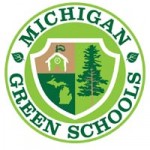
This past May 25th Joshua Rubin from Maxi Container met up with GreeningDetroit.com at the Green School Awards in Pontiac, MI. Maxi has been a member of their online community for about a year now and have met many people through there green network. We often see each other at green events throughout the spring/summer season. That is how this collaboration came about, at the Plymouth Green Street Fair we decided to work together and donate a compost tumbler to the Michigan Green Schools at there upcoming award ceremony.
Maxi believes that education is key if you want to make a positive change for the future. (see our articles about recycling in the classroom and Michigan’s Green Schools.) This was our chance to get directly involved and meet representatives from different Michigan Green Schools. We delivered a fully assembled Compost Tumbler with custom spray painting of GreeningDetroit.com and Maxi’s Logos (plus a flat black finish on the wood frame to boot). The donation of the composter was announced during the ceremony and schools were asked to sign up for it if interested. It would be raffled of a lucky school and then handed around to others. Hopefully the schools will need more composters soon! Maxi loves to be involved with our local schools, helping students to learn about the many benefits of composting.
Check out the Facebook photo album here.
Tags: Compost, compost tumbler, Composter, Composting, green schools, GreeningDetroit.com, Michigan
Posted in Blog, Latest News | No Comments »
Thursday, June 2nd, 2011
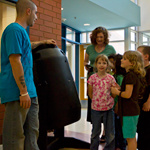
I recently participated in Steenland Elementary (Roseville) Special Person’s Day, where students bring their closest family or friend of their choosing to celebrate their Green School. The green fair included a scavenger hunt for the kids all while showcasing what they have been learning this year about being green.
The kids were ecstatic to be in school but not in class, they were there just to have fun. I was there to teach them, and connect with their parents discussing the benefits of rain barrels and composting. Kids love to play in the dirt so explaining compost is easy, but trying to get kids interested in water conservation is difficult, especially since I was operating the table by myself, I did not have time to setup the water cycle for our rain barrel display. It was not too much of a problem, after all kids have great imaginations.
It was a quick meeting, lasting about two hours. The school was filled with non-stop smiles and laughter and of course, the occasional cry. Overall, it was a enjoyable experience and it seemed as though all of the kids and their special person’s had fun. Steenland Elementary ended up buying a rain barrel for the kids to use in their garden at the school. Thank you Steenland for inviting me to join your special persons green fair, it was a blast!
Here are some photos from the event [ Photos by Michael Burd ]
Tags: Compost, compost tumbler, Education, green schools, Rain Barrel, Roseville, school
Posted in Blog, Latest News | No Comments »
Wednesday, June 1st, 2011
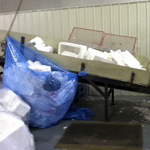
I recently got the chance to take a tour of Dart Container’s recycling facility. Dart has a statewide (and further) polystyrene (also known as Styrofoam) recycling program, where they collect used polystyrene from the food service industry, schools, county recycling drop offs; and people send them polystyrene to be recycled. Dart’s trucks go within a one hundred mile radius of Mason, MI (right outside Lansing), reaching forty-four county sites in twenty counties. Dart does this as a public service and they do not necessarily make money recycling, they do it because it is simply the right thing to do (being as they are primarily a new polystyrene manufacturer).
The process itself is quite amazing; they have a few employees who sort the trash before it gets processed. There are three different levels of polystyrene, which ends up as three different colors/qualities of usable resin. After being sorted the polystyrene is melted back down and then cooled in water. Little pellets are created, and they are slightly bigger than normal virgin plastic pellets and a little smaller than a pea.
Dart faces a few difficulties in this recycling system, first is transportation and second is finding suitable end-users, or basically what to do with all the plastic resin they reclaim. Lets start with transportation: recyclers get paid in weight; Styrofoam is 90% air and therefore, a truckload of polystyrene is not worth much to traditional recyclers. Long haul drivers are expensive because of this. For these reasons, getting truckloads of Styrofoam can become very costly.
Finding end-users who can use this product and put it back out into the mainstream is a whole task in and of its self. Currently their recycled polystyrene is being made into picture frames, rulers, Frisbees, toys, it has even been used as filler underneath concrete. Still it remains a continuous effort to find enough end-users to take their product because some industries cannot use it, such as the food service industry. The regulations will not allow post-consumer content unless they were returned to them within forty-eight hours for the original point of use, which is usually impossible. Ideally, Dart would like to go directly to the end user, knowing where and what their product is turned into. Since they cannot find enough end users, they have to occasionally sell to brokers. These are people who are in the business of buying from product and selling it to end users for a profit.
Next lets dispel some myths about polystyrene; all foam is simply not the same. At Dart, they deal exclusively with #6 polystyrene, which was created and patented by Dow Chemical. Though Styrofoam is petroleum based, it actually takes very little compared to other plastic products. Only twelve to fourteen little teeny tiny beads go into a coffee cup. If you are interested in learning more about polystyrene, it’s life cycle analysis and how it stacks up compared to paper, corn and other plastic products please visit their website.
For more information visit please visit Dart Environment on Facebook here.
Below are some pictures of from my tour of Dart’s recycling facility, enjoy!
Tags: dart, Enviroment, Michigan, polystyrene, Recycling, styrofoam
Posted in Blog, Latest News | No Comments »
Thursday, May 26th, 2011
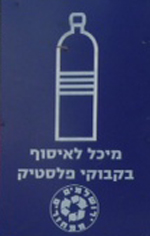
My wife Gail, daughter Michelle and I are on a long overdue trip to Israel. We have visited many ancient religious sites, museums, open air markets (Souq) both in the old and new cities of Jerusalem. So what caught my attention the most? The communal street side recycling bins for both paper and plastic.
Jerusalem does not yet have citywide curbside recycling. While there is a new recycling center that you can take your recycling to, it is underutilized. (See the Jerusalem Post article about it here)
As you might expect for the Middle East, Jerusalem is hot! Everyone carries bottles of water, soda, juice and other liquids to stay hydrated. In the U.S. there usually is no place to recycle plastic bottles while out in public. My family holds onto them until we can get home and put them in our recycling bin. But here in Jerusalem, they have taken a different approach. Every few blocks there are big wire mesh cages with different bottle size holes in them. Jerusalem residents (and tourists) do not have to go far to recycle those empty plastic bottles.
The same goes with newspapers. There are over twenty-two daily newspapers in Israel, a country with only 7.6 million people. Add to this all of the weekly papers including political, sports, and foreign language and you have a large amount of material to recycle. Again, due to the lack of curbside recycling (I think that it might be impossible to get a truck down some of these narrow streets) Jerusalem has taken a communal approach by installing large paper recycling drums, which are located every few blocks. After years of complaints about how ugly they look and the difficulty of putting anything other than newsprint in them, Jerusalem is now rolling out sleek blue boxes for curbside recycling that will accept all types of paper or cardboard! To find out more about Jerusalem’s new paper recycling systems read Jerusalemite’s article here.
My family agrees that there is much less litter in Jerusalem than many cities we have visited, both in the U.S. and overseas. It is a pleasure to wander its tree-lined streets armed with the knowledge that you can recycle that empty plastic bottle just about anywhere down the street.
Here is some pictures of recycling in Jerusalem, Enjoy!
Tags: Curbside Collection, environment, Israel, Jerusalem, Paper, Plastic, Recycling
Posted in Blog, Latest News | No Comments »
Wednesday, May 18th, 2011
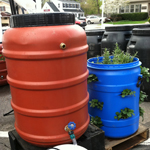
Maxi Container kicked of the spring season this year with a busy schedule. We participated in Green Fairs in Grosse Pointe, Plymouth, and Rochester. Community based events like these are a good way for us to meet the public and get feedback on our products, while educating people about water conservation, composting and container gardening. This past year we have redesigned our home and garden products, added new ones, and increased our commitment to green living by getting as heavily involved in these type of events.
Local Motion Green hosted an Earth Day Celebration on April 30. This was the first time Maxi had gone to Grosse Pointe Farms, and the response was tremendous. We had a great time talking to people who were excited about gardening and sustainability. The atmosphere was excellent with live music and events for kids too! Maxi also donated fiber drums to be used as recycling bins at Grosse Pointe Academy. You can read the whole article here.
The next weekend was the Plymouth Green Street Fair, May 6, 7, 8. Last year this was a great weekend, full of fun and friends. (Joshua and Richard are from nearby Farmington Hills) This year it was nothing less. Maxi was met with huge response on our Rain Barrels. We sold out! It was a fun filled weekend, which included a musical performance from American Idol runner-up Crystal Bowersox. They dyed the fountain green and even had a FLASHMOB (public choreographed dance) randomly in the center of downtown. Overall we had a wonderful time in Plymouth. (It helped that our tent was across from the amazing Plymouth Coffee Bean.) To view pictures from the event click here.
Last weekend (May 13, 14, 15) was the Rochester Green Living Festival, which has a strong reputation as being one of the premier green fairs in Metro-Detroit. They provide a rich experience, full of activities, entertainment and green vendors. There is something for everybody. The festival started as an Earth Day Expo and has grown significantly over the past few years. Unfortunately, this year was plagued with bad weather. On and off showers on Saturday detoured some, but we still did well. Sunday was a wash out, too cold for most to want to leave the house, with almost no attendees. Maxi still enjoyed being in Rochester for the first time, meeting all of the eco-conscious people looking for ways to reduce their carbon footprint and live a more sustainable life. Thank you Rochester and we hope for better weather next year!
Our upcoming events are the Ferndale Live Green Fair July 15-17, which takes place in Downtown Ferndale (9 mile and Woodward Ave.). The same weekend, on Saturday July 16, our very own Joshua Rubin will be in Armada, MI at the Lavender Festival, giving a Rain Barrel workshop/class. Maxi will also be at Birmingham’s Green Breeze on July 23, on Old Woodward between Maple and Brown Street. Please come out and join us at these GREEN events!
Tags: 2011, Birmingham, compost tumbler, Contianer Gardening, Crystal Bowersox, earth day, events, Ferndale, Green, Green Breeze, Green Fair, Grosse Pointe Academy, Grosse Pointe Farms, Joshua Rubin, July, Live Green, Live Green Fair, local motion, Local Motion Green, Metro-Detroit, Plymouth, rain barrels
Posted in Blog, Latest News | No Comments »
Tuesday, May 3rd, 2011
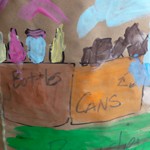
On Saturday April 30, 2011 Richard and Joshua Rubin represented Maxi at the Grosse Pointe Farms Earth Day “Green” Fair. The fair was hosted by Local Motion Green, a grass-roots organization involved in helping raise public awareness by putting on community-based events. Their mission is to illuminate the links between environmental toxins and negative health consequences, in an effort to influence personal and industrial behavior, as well as promoting improved health and quality of life. Melissa Sargeant, (Education Coordinator) of Local Motion contacted Maxi asking if we would like to be involved, and we are sure glad she did. This is one event we definitely did not want to miss!
The fair took place under one big tent in the Richardson Elementary parking lot. From 10am – 4pm, the lot was buzzing with activity, full of interested people wishing to reduce their carbon footprint by going green. Of course we had our Rain Barrels, Compost Tumblers, and new for this season, our Container Gardening display. Maxi also donated four fiber drums to be decorated by children and repurposed as recycling bins at the Grosse Pointe Academy. (Maxi believes in teaching green practices at an early age, see our article about Michigan Green Schools and our OPrep article about recycling in the classroom.)
Maxi had a great time meeting people and explaining our mission and about our products. We would like to formally say thank you to Local Motion Green for contacting us and look forward to working together in the future.
To view all the photos from the event check out the slideshow below.
For more information about Local Motion Green give them a call at 313-881-2263 or send them an email.
Tags: compost tumbler, container gardening, earth day, Fiber Drums, grosse pointe, Local Motion Green, Rain Barrel, Recycling
Posted in Blog, Latest News | No Comments »
![]()







